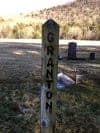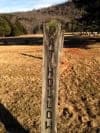Pepacton Cemetery to have gravestones cleaned and repaired
IT'S A HIGH and lonely place even on a sunny day in late February, with only the wind to keep you company. Through a break in the hills, you can see Pepacton Reservoir twinkling in the late afternoon sun.
This is Pepacton Cemetery, which was established by New York City to reinter the bodies from about 21 cemeteries that were to be flooded in the creation of the Cannonsville and Pepacton Reservoirs in the 1950s.
There are about 1,000 bodies here, about a fifth of the bodies that had to be removed for the construction of the reservoirs. A total of about 4,500 bodies needed to be reinterred. At the time, families were offered the opportunity to reinter the bodies of relatives in cemeteries of their choosing. The graves here are for bodies unclaimed by relatives.
The New York City Department of Environmental Protection just announced a rehabilitation project for this cemetery, with plans to clean and repair more than 300 headstones this spring. Gravestone Cleaning Service, based in Delhi, NY, is doing the work.
Many tombstones are tilted and some markers are hard to read. This project will clean, repair and in some cases, replace monuments that have not weathered well.




Pepacton Reservoir lies mostly east to west, like an undulating Chinese dragon with the small hamlet of Downsville in its mouth. The road the cemetery is on — BWS (Bureau of Water Supply) Road #6 — rides the back of that dragon, and the cemetery is about 20 minutes out of Downsville. It's easy to spot as it's the only cleared field anywhere on the road, and the views from the graveyard are stunning.
For the most part, the graves seem scattered, without much order. But there's a faded drawing in a covered shed that maps the graves, and another lists all the bodies buried here with details of where they are interred and where the bodies were from: Cannonsville, Rock Ridge, Rock Royal, Cat Hollow, Arena and New Arena. Place names now mostly lost.

As you wander the site, you notice markers with those names on them — allocating areas of this cemetery to specific cemeteries. Family names are also written on those markers, like Brewer and Duffy. It's easy to imagine the small family plots that these graves originated from. What's harder to imagine is that their families moved on or died out. Perhaps moving and reinterring relatives was just too sad.
All those markers seem to be themselves a sort of gravestone, marking not just the deceased, but towns long lost.
For more information
New York City Department of Environmental Protection is inviting descendants of those buried in the cemetery to contact them with any questions. Direct them to DEP's Regional Manager, Chris Gozza at 607-363-7003.
